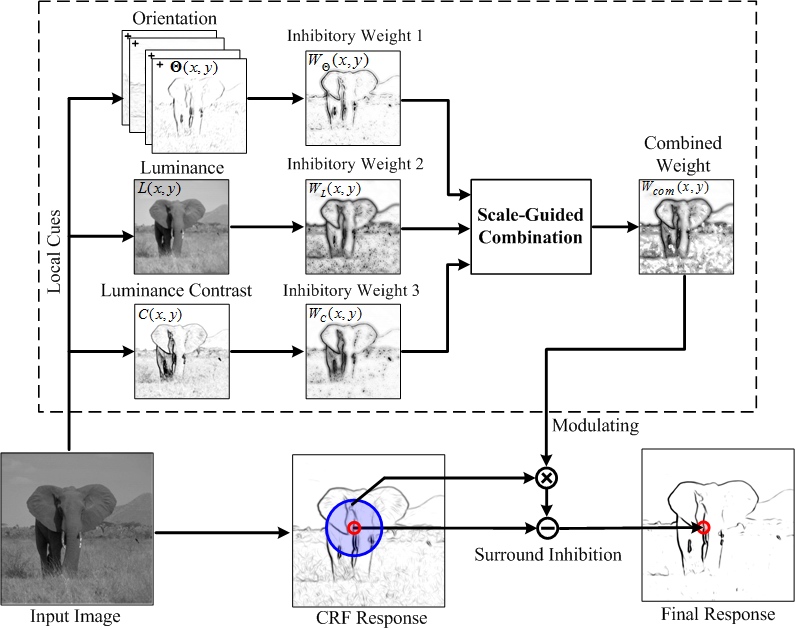Multifeature-based Surround Inhibition Improves Contour Detection in Natural Images
Kai-Fu Yang, Chao-Yi Li, Yong-Jie Li*
University of Electronic Science and Technology of China
Shanghai Institutes for Biological Sciences, CAS
Abstract
To effectively perform visual tasks like detecting contours, the visual system normally needs to integrate multiple visual features. Sufficient physiological studies have revealed that for a large number of neurons in the primary visual cortex (V1) of monkeys and cats, neuronal responses elicited by the stimuli placed within the classical receptive field (CRF) are substantially modulated, normally inhibited, when difference exists between the CRF and its surround, namely, non-classical receptive field (non-CRF), for various local features. The exquisite sensitivity of V1 neurons to the center-surround stimulus configuration is thought to serve important perceptual functions including contour detection. In this work, we propose a biologically motivated model to improve the performance of perceptually salient contour detection. The main contribution is the multifeature-based center-surround framework, in which the surround inhibition weights of individual features, including orientation, luminance and luminance contrast, are combined according to a scale-guided strategy, and the combined weights are then used to modulate the final surround inhibition of the neurons. The performance was compared with that of single-cue-based models and other existing methods (especially other biologically motivated ones). The results show that combining multiple cues can substantially improve the performance of contour detection compared to the models using single cue. In general, luminance and luminance contrast contribute much more than orientation to the specific task of contour extraction, at least in grey-scale natural images.
Method
The general framework of the proposed model.

The flowchart of multiple feature based computation of surround inhibition weights.
Results

Results of various models on two example images from RuG40 dataset. The number on the top of each image indexes its performance (P value).

Citation & Download:
- Kai-Fu Yang, Chao-Yi Li, and Yong-Jie Li*." Multifeature-based Surround Inhibition Improves Contour Detection in Natural Images." IEEE Trans. Image Processing (TIP), 23(12):5020-5032,2014. [pdf] [bib] [code] [published link]
Reference:
- Z.-M. Shen, W.-F. Xu, and C.-Y. Li, "Cue-invariant detection of centre– surround discontinuity by v1 neurons in awake macaque monkey," J. Physi., vol. 583, no. 2, pp. 581–592, 2007.
- Grigorescu, N. Petkov, and M. A. Westenberg, "Contour detection based on nonclassical receptive field inhibition," IEEE Trans. Image Process., vol. 12, no. 7, pp. 729–739, 2003.
- Chi Zeng, Yongjie Li*, Chaoyi Li. "Center-surround interaction with adaptive Inhibition: a computational model for contour detection", NeuroImage, 55(1), 49–66, 2011.
- D. R. Martin, C. C. Fowlkes, and J. Malik, "Learning to detect natural image boundaries using local brightness, color, and texture cues," IEEE Trans. Pattern Anal. Mach. Intell., vol. 26, no. 5, pp. 530–549, 2004.
